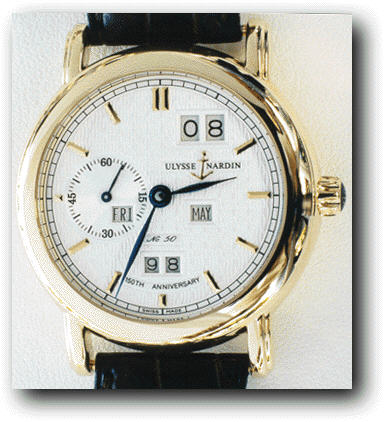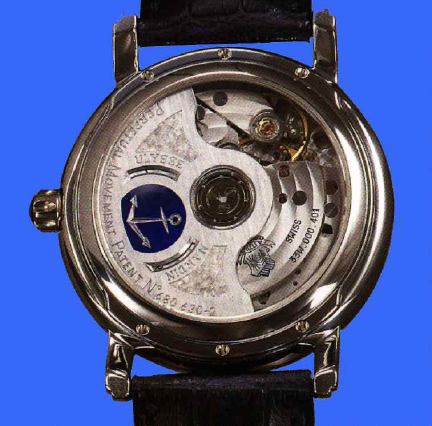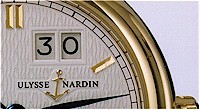Ulysse Nardin Perpetual Ludwig
Review by Ludwig


I first saw this watch at Chatel in Carmel, where I was dropping by to pick up a birthday present for myself (a Minerva Avus II/Aviator '45, but that is a tale for a different day). I immediately fell in love with the Edwardian/H.G. Wells look of the watch, as well as its extremely clever design. Hugues Beck, the ever-helpful proprietor, spent some time with me explaining the movement, and its features. I was hooked. Frankly, I had never before seen a watch that hit me with this sort of emotional impact. I decided that further research, and a cooling off period, were in order, and I barely escaped the store on that occasion without buying the Ludwig.
This turned out to have been a serious mistake.
This watch tormented me in my dreams. It drove me on a seemingly endless quest to buy Yet Another Watch (the dreaded Watch Acquisition Syndrome), to somehow take its place in my soul. Those of you who have had the disease will understand. I would have saved serious time, anguish, and money, if I had just gone ahead and got the watch of my dreams to start with.
Finally, after several months, it was clear that the only way to get the monkey off my back was to boldly embrace it. I called up Chatel, and negotiated its purchase for a price that in earlier days I would have thought an insane amount of money to pay for a mere watch. I drove down to Carmel, picked it up, and lived happily ever after.
Or at least I should have. Some minor issues surfaced with the watch which required it to be sent back to Switzerland for repair. I got it back in 8-9 weeks, and I was kept posted of its progress by my dealer, but the withdrawal pains touched off by its absence started the W.A.S. again...
I did learn from this experience, though. Now, if I find a watch that I really like, and it passes the 2 week scan-as-screen-wallpaper test, I pretty much surrender to my addiction and buy the darned thing :-)
Absolutely! After 6+ months, I still love this watch. I have a hard time not smiling when wearing it. I may have to buy some nice clothes, so that it is not embarrassed to be seen with me.
Yes I would, though I would also give serious thought to the platinum and rose gold versions. I can't quite decide which is the nicest looking.
The Ludwig's movement is the Ulysse Nardin Calibre 33, issued for the 150th anniversary of U.N. in 1996. I believe that it is based on the Lemania 1354 chronograph movement, though some believe it to be an ETA 2892A2. (If anyone knows for sure, please let me know.) It is autowinding, 31mm in diameter, 6.95mm high, with 34 jewels and 223 parts.
The ball bearing central rotor is made of white gold, and weighs 4.05 grams. It is hand-engraved, and has a lovely deep blue Ulysse anchor logo done in enamel embedded in it.
The movement is covered by U.N.'s patent #680-630-2. It is C.O.S.C. certified, and comes with the rating certificate. The movement does not hack, but will stop (or even run backwards) with a wee bit of backpressure on the crown.
The watch was named after, and designed by, Ludwig Oechslin, U.N.'s "Master of Innovation". He also designed the Trilogy of Time and the GMT+ for U.N. I also hear that he designed the Marine Chronometer 1846 power reserve complication.

The movement is technically quite interesting. It is the only perpetual, other than the UN Trilogy pieces Planetarium and Astrolabium, that I am aware of that can have its calendar adjusted easily forwards and backwards with a simple twist of the crown. When you set the time back (when travelling westward, for example), the date even properly rolls back. The way the calendar-setting works is that the quick-adjust position of the crown moves forward/backwards the date/month/year, while the time-setting position of the crown moves the day of week whenever you advance/retard the time through 24-hours. This also allows the user to adjust the watch for the year 2100AD himself, instead of sending the watch in for adjustment. (I factored this cost savings into my purchase decision :-)
Bear in mind that most perpetuals, such as the JLC Master Control Perpetual , cannot be adjusted backwards at all.
The large date is another cool feature of the Ludwig.
The design is different from
the large date of much-discussed Lange 1, and was designed
independently. It consists of two disks, one a ring for
the ones-digit, the other a Maltese cross for the tens-digit, which
rotate on the same level to form the date. The date changes quite
rapidly, at almost exactly midnight.


